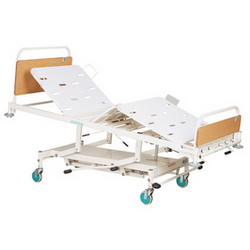Many people are oblivious of what it takes to give quality health care to a loved one at home, unless they work in the medical field. Without sufficient health insurance coverage, a patient has minimal choices on health care and home nursing care becomes a preferred choice to minimize on medical bills. At this point, long-term home nursing care equipment, like Vitality medical beds, is required.

Post accident care
If a patient was involved in an accident, not only does it become necessary to invest in special lift Vitality medical beds but maybe also a wheelchair and crutches, or walkers, depending on the person's age and overall medical condition. This facilitates easier movement as the limb remains in a cast. Some automobile accidents require extended stays in hospital. For example, a patient with a spinal injury will stay for a longer period in hospital. However, after discharge they will require a medical bed to facilitate long-term medical care. Vitality medical beds offer musculoskeletal support for such patients, along with other aids, such as, a lift chair.
Long term care
In-patient health care is not limited to a hospital stay; this can be extended to the home too. This may not necessarily be because of low health insurance coverage, but a patient may prefer to recuperate at home with the support of the family. Some patients find recuperating at home much more conducive for a quicker recovery than a hospital stay. With Vitality medical beds, a patient is as comfortable as they would if they were in hospital. Patients suffering from terminal illness find hospitals too lonely for their limited lifespan. The logistics of visiting a patient frequently makes it more challenging for the loved ones too; hence, the patient may opt for long term health care at home. Investing in a medical bed, such as those provided by Vitality medical beds, makes it easier.
Taking care of Vitality medical beds
Vitality medical beds consist of a frame, headboard, mattress, side rails footboard and other accessories. Elderly and frail patients have a high risk of entrapment in the opening within or between the side rails and the mattress, or between the side rails and the footboard or headboard. Therefore, it is critical to reduce the risk exposure. Here are some guidelines to reduce such risks:
- First, read the manual provided by Vitality medical beds to understand how to operate the bed effectively.
- Make an assessment of the patient's abilities and determine if they require side rails. If they do, ensure that the connection to the other bed components do not aggravate the risk of their entrapment. For example, the bars on the side rails should be spaced closely enough to prevent head entrapment.
- Inspect the side rails regularly and ensure they work properly.
- Ensure the mattress is proportionate to the bed frame and the space left between it and the side rails is too small for entrapment.
- In the event of entrapment, whether the patient is injured or not, reconsider their needs and the bed system to prevent future entrapment accidents.
- Ensure the bed is serviced and examined regularly as per need. If need be, upgrade and remove any unsafe apparatus.
